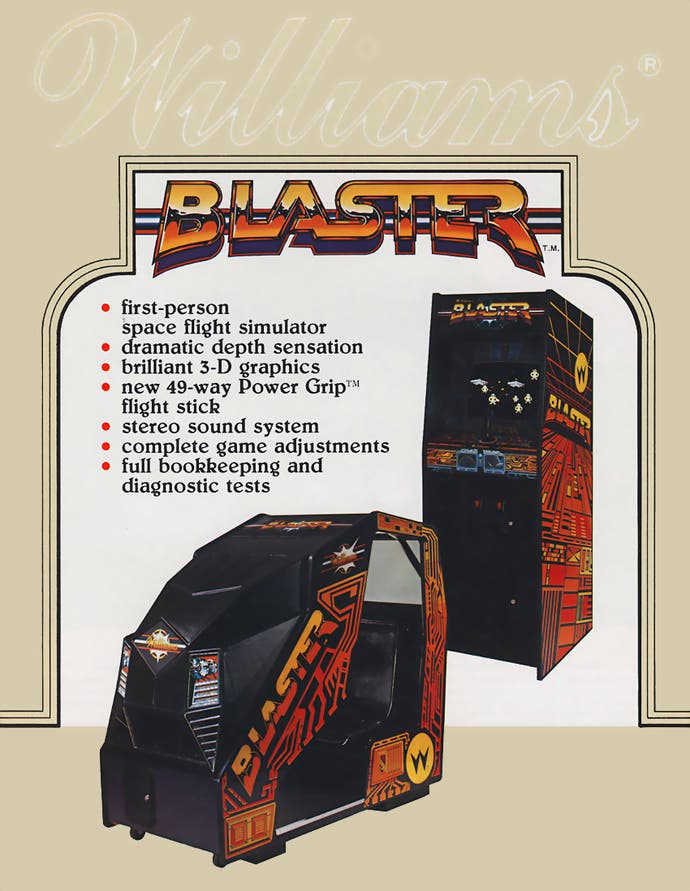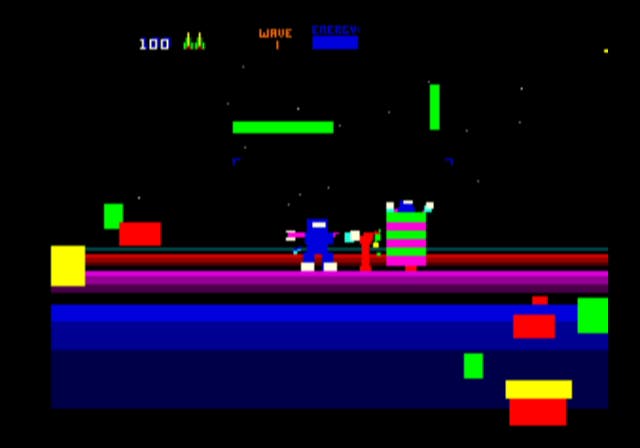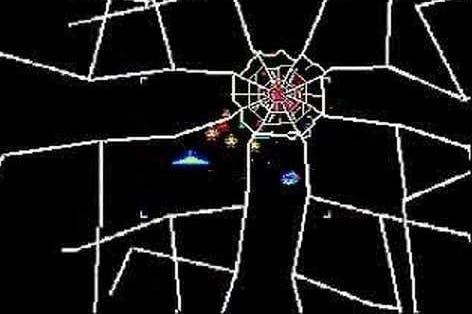Blaster retrospective
The year is 2085...
Every week or two I find myself wishing that Eugene Jarvis and Larry DeMar had made a sequel to Robotron 2084. Every year or so I remember that they actually did. Well, sort of.
After that, I have to lug the noble black plastic hulk of the original Xbox out of storage to discover whether this sort-of sequel is as weird as I remember it being. This brings us up to date. Up to date with yesterday, anyway, when I sat down with a pile of old cables, a dusty crate of superseded consoles, and Midway Arcade Classics - a gem of a compilation which, infuriatingly, never made the backwards compatible list for the 360.

The game I headed straight for was Blaster, Vid Kidz' third - and final - release, and an arcade adventure that starts with the goose-pimpling sentence: "The year is 2085."
2085. Yes please.
So, the Robotrons have won. They've finally defeated humanity, and you're thrown into the shoes of the last non-robo survivor, who legs it from Earth in a stolen spaceship, bound for a mysterious planet known only as Paradise.
You know those colourful inter-wave effects in Robotron? The ones that make it seem like you're falling head-first down a rainbow-coloured tube? Blaster appears to be based on those sections as much as it's based on anything. It's a very early first-person game that sees you racing straight through various different enemy encounters, blowing away a nutty collection of foes as you leap from wave to wave to wave. It's a very weird game to look at, using simple assets to create an illusion of 3D space, and perhaps the closest parallel that comes to mind is the original Starfox.
Like Starfox, you're broadly on rails, with a very limited ability to move your viewpoint around. And, like Starfox, you have to dodge incoming projectiles as well as blast enemies and collect the occasional thingummy.
If you're a fan of classic Williams games, though, you won't really be thinking about StarFox as you play it. No, you'll be thinking of Robotron or Defender, and it's the audio that will probably be guiding your mind. Blaster's filled with reappropriated sound effects, from the collection gulp as you snag a tumbling spaceman in the asteroid waves to the start-up swoosh as you jet into a fresh challenge. Weirdest of all is probably the Robotron smash effect, which is now accompanied by visuals suggesting your spaceship windscreen's just given in. Do spaceships have windscreens? No matter: it's still a weird, almost dream-like experience whenever it happens. I know that sound so well, but I associate it with different circumstances.
Alongside audio lifts from the classics, Blaster's riddled with the kind of touches only Vid Kidz could provide. I love the garishness of everything you come across: the lurid colour palette, and the chunky, angular sprites of the robots, space rocks and monsters you face. I love the burst of speed as you leave each level, as if you're fluid racing through a syringe. I love the sense of arcade hardware being pushed to its limits, of tech existing on the ragged edge of functionality, and just about doing things it wasn't meant to do. Vid Kidz, eh? In this respect, Blaster has the glorious kind of precariousness you can sense in later stages of Robotron: the fleeting realisation that everything could glitch and brown out at any moment, due to the insane strain the system's been placed under.
If Robotron's all about circling your foes, herding, negotiating a cramped environment and interpreting numerous different enemy threats at all times, Blaster's about forward momentum. Dead ahead, though this wave and then the one after. Onwards. Excelsior. In the service of forward momentum, in fact, Vid Kidz has sacrificed a little of Robotron's ability to create deadly organic life from a selection of moving parts. Blaster's shooting galleries are dazzling to behold, even today, but they lack the emergent bacterial wonders of Earth back in 2084. There are no grunts to flock into bait-balls, no Enforcers to bunch together in the corners.

Instead, each new wave piles on the nuttiness. Blaster's not so much chaotic as dementedly undisciplined, I suspect, but what you get for your troubles is an entire galactic map of oddness - a fully-fledged Jarvisian Macrocosm. There are waves of Vampire craft who ripple towards you in deadly chains, as if riding an invisible rollercoaster. There are time tunnels where disco cosmonauts - seemingly flung into proceedings from Defender - tumble through the vacuum. There are Cat Worlds, where you face flying felines who sort of resemble WW2 bombers. How much more of this stuff can you expect? Twenty waves, give or take the odd repetition, each of them filled with little bursts of brilliant arcade design: magic arches you can chain together as you zip along, saucer fleets which explode as one if you blast the red craft first. There are quirks, too, like the fact that your shots don't all race neatly down the centre of the screen, and that, alongside firing, you have a boost button to get you out of trouble - or thrust you right into the middle of it.
Wilful, strange, fiercely over-ambitious, it's probably no surprise that Blaster was a bit of a flop. Hitting arcades in 1983, its arrival coincided with the great video game crash, and its complex effects required equally complex kit that was expensive to make, meaning that few machines got produced. One model was also housed in Williams' Duramold cabinets: their tough plastic was hard for aggrieved punters to damage, but along with that, it had a habit of shrinking and then, you know, launching its monitor across the room.
On top of all that, of course, is the fact that, weird and charming as it is, Blaster is no Robotron. It lacks the original game's brilliance and vicious poise, it lacks its focus, its systemic clarity.
But it gives you something else instead. It gives you a glimpse of a wider, less-focused imagination, of a gimmicky, flashy, wacky and expansive game made by one of arcade's greatest design teams.
So does Paradise exist? Who knows, but if it does, the games there are made by Jarvis and DeMar.

